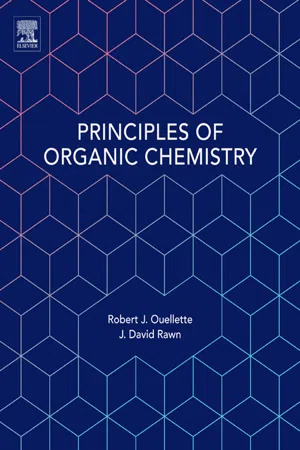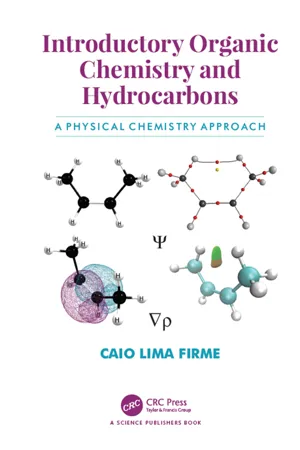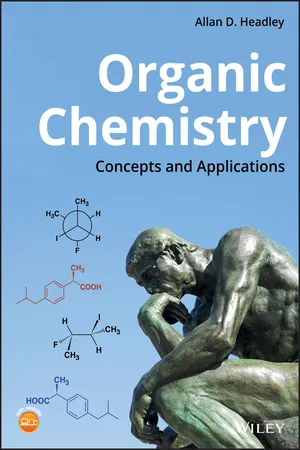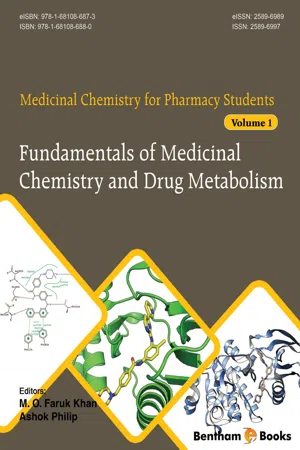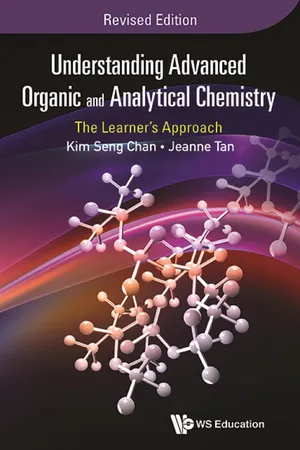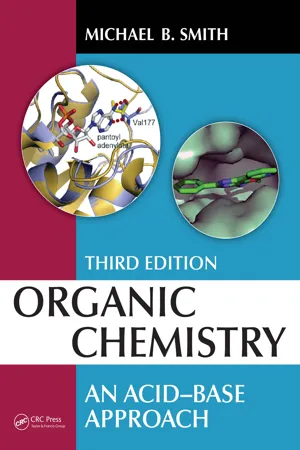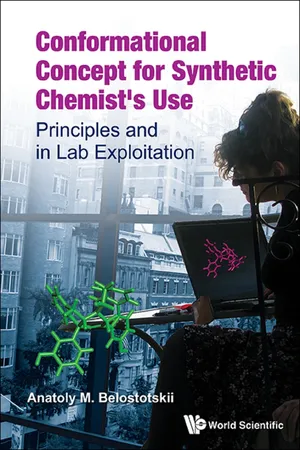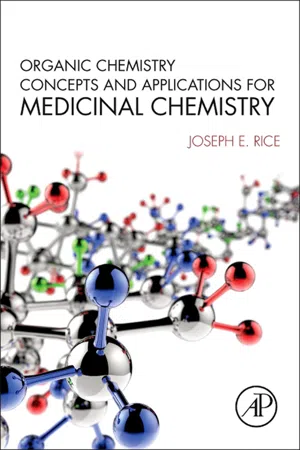Chemistry
Geometrical Isomerism
Geometrical isomerism is a type of stereoisomerism where different spatial arrangements of atoms result in distinct isomers. This occurs when rigid groups are unable to rotate around a bond, leading to different spatial orientations. The isomers have the same molecular formula and connectivity but differ in their spatial arrangement, affecting their physical and chemical properties.
Written by Perlego with AI-assistance
Related key terms
Related key terms
1 of 4
Related key terms
1 of 3
10 Key excerpts on "Geometrical Isomerism"
- eBook - ePub
- Robert J. Ouellette, J. David Rawn(Authors)
- 2015(Publication Date)
- Elsevier(Publisher)
6Stereochemistry
6.1 Configuration of Molecules
In Chapters 3 and 4 we considered the structures of geometric isomers, which are one of a general class of stereoisomers. Stereoisomers have the same connectivity—the same sequence of bonded atoms—but different arrangements of the atoms in space. The different three-dimensional arrangements of atoms in space determine their configurations. Geometric isomers have different configurations. The configuration of a molecule plays a major role in its biological properties. Stereoisomers often have entirely different biological properties. Geometric isomers invariably elicit different responses in organisms. For example, bombykol, the sex attractant of the male silk-worm moth, has a (Z)/(E) arrangement about the double bonds at C-10 and C-12. It is 109 to 1013 times more potent than the other three possible geometric isomers. Disparlure, the sex attractant of the female gypsy moth, is biologically active only if the alkyl groups bonded to the three-membered ring are in a cis configuration.Geometric isomerism is only one type of stereoisomerism. Another type of stereoisomerism is the result of the minor image relationships between molecules, the subject of this chapter. These molecules differ in configuration about an sp3 -hybridized, “tetrahedral carbon” atom bearing four different groups of atoms, which is called a stereogenic center. This phenomenon is not as easily visualized as geometric isomers, but its consequences are even more vital to life processes.6.2 Mirror Images and Chirality
The fact that we live in a three-dimensional world has important personal consequences. In the simple act of looking into a mirror, you see someone who does not actually exist—namely, your mirror image. Every object has a mirror image, but this reflected image need not be identical to the actual object. Let’s consider a few common three-dimensional objects. A simple wooden chair looks exactly like its mirror image (Figure 6.1 ). When an object and its mirror image exactly match, we say that they are superimposable. - eBook - ePub
Introductory Organic Chemistry and Hydrocarbons
A Physical Chemistry Approach
- Caio Lima Firme(Author)
- 2019(Publication Date)
- CRC Press(Publisher)
Chapter ThirteenIsomerism
ISOMERISM AND TYPES OF ISOMERISM
Isomerism gives rise to isomers that are molecules with the same chemical formula but different structural parameters or different spacial structures (different type of branching or different type of functional group or different position of the same functional group or different arrangement of substituents or different absolute configuration of the asymmetric atom).As for structural isomerism, there are three types: chain isomerism, position isomerism (or regioisomerism), and functional isomerism.The chain isomerism is related to the different position of the branching in its main chain. For example, butane and 2-methyl-propane are isomers (C4 H10 ); pentane, 2-methyl-butane and 2,2-dimethyl-propane are isomers (C5 H12 ); but-1-ene and 2-methyl propene are isomers (C4 H8 ) as well (see Fig. 13.1(A) ).Figure 13.1 Bond line formula of (A) chain isomers, (B) regioisomers, and (C) functional isomers.The position isomerism (or regioisomerism) is related to a different position of the substituent group or functional group in the molecule. For example, but-1-ene and but-2-ene are isomers (C4 H8 ), pentan-2-one and pentan-3-one are isomers (C5 H10 O), 2-chloro-propane and 1-chloro-propane are isomers (C3 H7 Cl), orto-dichlorobenzene and para-dichlorobenzene are isomers (C6 H4 Cl2 ) as well (see Fig. 13.1(B) ).Functional isomerism is related to different functional groups with the same molecular formula. For example, propanone and propanal are isomers (C3 H6 O), hexan-1-ene and cyclohexane (C6 H12 ) are isomers as well (see Fig. 13.1(C) ).Stereoisomerism is related to specific arrangements of substituents where two isomers are differentiated by their spacial disposition. Stereo means spacial.GEOMETRIC STEREOISOMERISM
Geometric stereoisomerm occurs in alkenes or derivatives and in substituted cycloalkanes. They generate two isomers called cis and trans or E and Z. - eBook - ePub
Organic Chemistry
Concepts and Applications
- Allan D. Headley(Author)
- 2019(Publication Date)
- Wiley(Publisher)
5 Stereochemistry 5.1 Introduction In a three‐dimensional world, our analysis of atoms and molecules must be from that perspective. In this chapter, a detailed examination of the three‐dimensional arrangement of atoms in a molecule will be carried out. The study of differences in isomers brought about by differences in location of atoms or groups in molecules in three‐dimensional space is called stereochemistry. Geometric and conformational stereoisomers have already been examined in the previous chapter. Geometric isomers differ from each other based on the arrangement of the atoms or groups across a rigid plane, such as a double bond or rigid cyclic ring in the molecule. For example, trans ‐1,2‐dichloroethene is different from cis ‐1,2‐dichloroethene since the chlorine atoms are on different sides of the rigid double bond. On the other hand, conformational isomers differ from each in that groups or atoms in the molecule are in different locations due to rotation about a single bond, typically a carbon–carbon single bond. Thus, the anti‐conformer of 1,2‐dichloroethane is different from the gauche conformer. These conformers are different only in the spatial arrangement of the groups around the carbon–carbon bond; and as a result, their relative energies are different. For some stereoisomers, it is extremely difficult to visualize differences that result in three‐dimensional space for molecules brought about by different spatial arrangements of the atoms or groups, unless a model set is used. Stereochemistry is the study of molecules that have the same atom–atom connectivity, but the spatial arrangement among the groups or atoms is different, resulting in different molecules, known as stereoisomers. Just as a pair of shoes looks similar, but the spatial arrangements in three‐dimensional space are different. Try putting on the left foot of the shoe on your right foot, it just will not fit since it is different from the right foot of a pair of shoes - eBook - ePub
Carbohydrate Chemistry
Fundamentals and Applications
- Raimo Alén(Author)
- 2018(Publication Date)
- WSPC(Publisher)
3. Isomerism
3.1.General
A general molecular formula (e.g., Cx Hy Oz Nn ) expresses the kind and number of the constituent atoms of a compound, but it insufficiently represents the structure of the compound in question. A molecular formula can thus correspond to several compounds (isomers) that normally have different chemical and physical properties. Isomers can be defined as chemical compounds with identical molecular formulas (i.e., contain the same number of atoms of each element) that differ from one another in the arrangements of their atoms. This phenomenon is called “isomerism” (in Greek, “isos” means “equal” and “meros” “part”), and it is divided into two main types (Fig. 3.1 ): (i)constitutional isomerismor structural isomerism and (ii)stereoisomerismor space isomerism. Upon examining certain isomers (such as aldoses with the same number of carbon atoms), one does not necessarily find differences based on constitutional isomerism, and finding the actual differences requires detailed comparison of the stereoisomeric properties of the structures.Constitutional isomerism can be divided into three subgroups: (i)functional group isomerism(“function isomerism”), (ii)chain isomerism(“skeletal isomerism”), and (iii)position isomerism(“regioisomerism”), which are discussed in the next chapters with the help of illustrative examples. The general name “structural isomerism” is traditionally used for “constitutional isomerism”. However, since the structure of the compounds can be thought to cause all isomerism, the use of the former term is not recommended.Fig. 3.1.The main types of isomerism and their subtypes.The branch of organic chemistry that examines the three-dimensional structures of molecules,stereochemistry, has gained importance when striving to understand the physical and chemical properties of various compounds. In carbohydrate chemistry, it is also essential to know the stereochemical structure of the compounds. Stereoisomerism can be seen to generally represent the form of isomerism where compounds with the same chemical structure (i.e., the order of attachment of the atoms involved and the location of the bonds between them) differ from each other only in the spatial direction of their atoms or atom groups. This isomerism is divided into (i)optical isomerism(“physical isomerism”), (ii)conformational isomerism, and (iii)geometric isomerism(“cis/trans - eBook - ePub
- John Wright(Author)
- 2004(Publication Date)
- Routledge(Publisher)
trans.- A chiral centre is one containing an asymmetric carbon atom and gives rise to stereoisomerism called optical isomerism. Optical isomers are optically active.
- Optically active chemicals can rotate the plane of polarised light. Optical isomers are non-superimposable on each other. By convention (+) isomers rotate the plane of polarised light clockwise, and (-) isomers rotate it to the left.
- Organic molecules can undergo a range of chemical reactions according to the functional groups present, e.g. oxidation, reduction, addition, condensation, hydrolysis and substitution reactions.
Questions
- From the pairs of molecules listed below, which
- (a) belong to the same homologous series
- (b) are position isomers
- (c) are functional isomers
- (d) are skeletal isomers
- (e) are identical molecules
- (f ) are none of the above.
- (i) CH3 CH2 CH2 OH
- (ii) CH3 CHOHCH3
- (iii) CH3 CHOHCH3
- (iv) (CH3 )2 CHOH
- (v) CH3 OCH3
- (vi) CH3 CH2 OH
- (vii) (CH3 )2 CHCH3
- (viii) CH3 CH2 CH2 CH3
- (ix) CH3 CH2 CH2 OH
- (x) CH3 OCH3
- (xi)(CH3 )2 CHCH2 Br
- (xii)CH3 CH2 CHCH3 CH2 Br
- An organic material, containing one carbon–carbon double bond has the molecular formula C3 H5 Cl. Draw all the possible structural formulae.
- Using the compound from (2) above, identify the one compound that can exhibit geometric isomerism.
- An ester, X, has the molecular formula C4 H6 O2 . It is suspected to have one carbon–carbon double bond in its structure.
- (a) Suggest a test that could be used to show that this compound contains a carbon–carbon double bond.
- (b) There are five possible structures for ester X. One of these structures exists as a pair of geometric isomers. Draw the five structures, showing which one exists as a pair of geometric isomers.
- (c) If the five possible esters are hydrolysed, what five alcohols will be formed? Which pair of alcohols shows positional isomerism?
- M. O. Faruk Khan, v Philip(Authors)
- 2018(Publication Date)
- Bentham Science Publishers(Publisher)
L -isomer, which may account for its differential absorption, protein binding and metabolism. Thus, the chirality or stereochemistry of drugs is an important factor to be considered for therapeutic agents. The following sections consider different stereochemical features of drugs. Definitions and illustrations are included to aid in understanding the different conformational and configurational aspects of drugs.Stereochemical Definitions and Illustrations
Isomers are molecules with identical molecular formulas but different structural formulas or different stereochemical formulas and hence different physical and/or chemical properties. Molecules having identical molecular formulas but different structural formulas are termed structural isomers. For example, ethanol (CH3 CH2 OH) and methyl ether (CH3 OCH3 ) are structural isomers as both have the same molecular formula (C2 H6 O), but different connectivity of atoms. Structural isomers would be expected to have very different physical/chemical characteristics (i.e. color, melting point, solubility, etc.).Stereoisomers come about from chirality or from restricted rotation such as in a ring or olefinic (double) bond. There are two obsolete terms that have been used in the past with respect to stereoisomers. The first, optical isomers, is used to describe stereoisomers with different optical properties. These optical properties arise from chirality and will be discussed under that topic. The second, geometric isomers, is used to describe cis-trans isomerism.Chirality is a geometric property whereby a molecule (or any rigid object for that matter) is not superimposable on its mirror image. Chirality arises either from chiral centers or from restricted rotation, referred to as axial chirality. Stereoisomers have identical molecular and structural formulas but they have different spatial arrangements of the same groups. Physical or chemical characteristics of steroisomers are usually different (except see enantiomers).- eBook - ePub
Understanding Advanced Organic and Analytical Chemistry
The Learner's ApproachRevised Edition
- Kim Seng Chan, Jeanne Tan;;;(Authors)
- 2016(Publication Date)
- WS EDUCATION(Publisher)
CHAPTER 2
Isomerism in Organic Compounds
2.1 Introduction
If a molecule has the molecular formula C4 H8 , does it imply that all the C4 H8 molecules are identical? The alkene, but-1-ene, whose molecule is shown below, has the molecular formula C4 H8 .Yet, C4 H8 also represents the formula for cyclobutane, which belongs to the cycloalkane family:Compounds that have the same molecular formula but different structures are known as isomers. This phenomenon is known as isomerism. The two main types of isomerism are constitutional/ structural isomerism and stereoisomerism. These are further divided into subclasses of which some are discussed in this chapter. Isomers generally have different physical and chemical properties, but they can also have similar chemical properties if they contain the same functional groups. Each specific functional group possesses a characteristic set of chemical reactions.2.2 Constitutional/Structural Isomerism
Constitutional/structural isomers are compounds with the same molecular formula but different structures or structural formulae. Both but-1-ene and cyclobutane constitute a pair of constitutional/structural isomers. The difference in structures can be attributed to either a difference in the arrangement of atoms or due to the presence of different functional groups.Based on the above definitions, constitutional/structural isomerism can be classified into three main types:• chain isomerism;• positional isomerism; and• functional group isomerism.2.2.1 Chain Isomerism
Compounds that exhibit chain isomerism with each other have the same functional group but differ in the way the carbon atoms are connected in the mainskeletal carbon chain of their molecules. In other words, these molecules differ in the degree of branching, hence the term chain isomers - eBook - ePub
Organic Chemistry
An Acid-Base Approach
- Michael B. Smith(Author)
- 2022(Publication Date)
- CRC Press(Publisher)
Chirality, Enantiomers, and DiastereomersDOI: 10.1201/9781003174929-9The video clips for this chapter are available at: https://routledgetextbooks.com/textbooks/9780367768706/chapter-9.phpThis chapter will focus on a class of isomers that differ only in the spatial arrangement of attached atoms and groups about an atom. When two different molecules have the same atoms, groups, and the same empirical formula, they are isomers. When they have the same points of attachment (the same connectivity), but differ in the spatial arrangement of those groups, they are different molecules known as stereoisomers .To begin this chapter, you should know the following points:- Name organic molecules, based on the nomenclature rules (Sections 4.4,5 and 5.1–5.6).
- The VSEPR model for drawing structures (Section 3.6).
- σ-bonds. (Sections 3.3 and 3.8).
- π-Bonds. (Sections 5.1–5.3).
- Constitutional isomers (Sections 4.2 and 4.4).
- Rotation about covalent single bonds (Section 8.1).
- Conformations of acyclic molecules (Sections 8.1–8.3).
- Conformations of cyclic molecules (Sections 8.5–8.7).
- Physical properties associated with organic compounds (Section 5.8).
9.1 Stereogenic Carbons and Stereoisomers
Defining a Stereogenic CenterA mirror image is defined as an image or object that is identical except that the structure is reversed. A “W” and its mirror image are shown and it is easy to see that one “W” can be placed on the mirror image “W” so they are completely superimposable . In other words, the two images represent one “W,” not two.Since the “W” is symmetrical there is a plane of symmetry as shown. When a sp3 -hybridized carbon has four identical atoms or groups attached the mirror image of that molecule is superimposable. Such a molecule has symmetry and if it is superimposable, it is the same molecule. An example is methane. There is a plane of symmetry that bisects the central carbon and two of the hydrogen atoms, illustrated by the pane through the tetrahedron superimposed on methane in Figure 9.1 - eBook - ePub
Conformational Concept For Synthetic Chemist's Use: Principles And In Lab Exploitation
Principles and in Lab Exploitation
- Anatoly M Belostotskii(Author)
- 2015(Publication Date)
- WSPC(Publisher)
Geometries of Organic Molecules: Is There a Place for a Simple Look?1.1 Building Blocks of Molecular Geometry: Elementary Fragments
Most multiatomic organic molecules have three-dimensional (3D) structures. This feature of invisible subnanometer matter is explicitly fascinating to organic experimentalists due to the existence of astonishing species that have the same elemental composition as well as the same chemical connectivity, and yet, are different individual compounds. Discovered by purely chemical methods, the phenomenon of non-constitutional isomerism was the first unambiguous message from the 3D molecular world. Characterized as individual species many years ago, carbohydrate stereoisomers are an impressive example. For instance, there are 32 aldopyranoses: α-D-allo- α-D-altro-, α-D-gluco-, α-D-manno-, α-D-gulo-, α-D-ido-, α-D-galacto-, α-D-talopyranose, eight corresponding β-D-saccharides as well as 16 pyranoses of the L-series. Within the limits of the covalence meanings, it is impossible to explain this number without assuming a 3D arrangement of atoms in pyranose molecules.Isolation of stereoisomers for many organic compounds of quite different chemical classes shows that non-planar arrangements of atoms in molecules are common. Physical methods, X-ray diffraction, and electron diffraction, by “displaying” molecular geometry, directly confirm this; theoretical chemistry provides solid milestones for trustworthily modeling any 3D molecular structures. Fortunately for organic chemists, the 3D labyrinth of polyatomic constructions does not appear to be infinitely complex. A very general, abstract, description of molecular geometry of organic compounds may be formulated in two statements: (1) molecular frameworks are formed by 3D building blocks that possess certain geometries and (2 - Joseph E. Rice(Author)
- 2014(Publication Date)
- Academic Press(Publisher)
Chapter 2The Three-Dimensional Structure of Organic Compounds
Abstract
This chapter opens with a discussion of the various types of isomers leading into a more detailed look at stereoisomerism. The concept of optical isomers at saturated asymmetric centers is then introduced along with a discussion of the properties of enantiomers and the methods used to designate absolute configuration at such stereocenters. Diastereomers are then discussed as being stereoisomers that are not enantiomers. The idea of prochirality is introduced and examples of saturated prochiral centers and unsaturated prochiral faces are given. Stereoisomerism at unsaturated centers is then discussed along with a system to designate those isomers. The last section deals with conformations, beginning first with acyclic systems and then progressing to cyclohexanes, and finally to five-, four-, and three-membered saturated rings.Keywords
Absolute configuration ; Chiral center ; Conformation ; Diastereomer ; Dihedral angle ; Eclipsed ; Enantiomer ; Isomer ; Nonbonded interactions ; ProchiralOne of the critical factors associated with drug–receptor interactions is the three-dimensional structure of both the drug and receptor molecules. Efficient interaction between a drug and its receptor depends not only on the absolute and relative positioning of groups in space but also on the ability of the molecule to modify its shape by rotating about single bonds. These aspects of chemical structure are known as stereochemistry and conformation and are the topics covered in this chapter.Isomers
Two or more compounds that have the same empirical formula but differ with respect to how the various atoms are joined are called isomers . Isomers are broken down into two broad categories. The first is constitutional isomers —compounds that differ in constitution or make-up. Thus cyclopropane and propylene (Figure 2.1 ) are constitutional isomers because cyclopropane is composed of three CH2 (methylene) groups arranged into a three-membered ring, whereas propylene is acyclic with a vinyl and a methyl group. The alcohols n -propanol and i -propanol are also constitutional isomers that are similar chemically but differ in the position to which the hydroxyl group is attached (also called positional isomers ). Thus n -propanol has the hydroxyl group attached to methylene with an ethyl group attached to the same carbon. In contrast, i -propanol has the OH group attached to a CH (methine) that is also attached to two methyl groups. Another example of this is seen with isobutylene and cis - or trans -2-butene. Isobutylene has one sp2 -hybridized carbon with two methyl groups and another one with two hydrogen atoms attached, whereas cis - and trans -2-butene have two sp2 carbons each with one methyl group and one hydrogen atom. Thus, isobutylene and cis - or trans -2-butene are constitutional isomers. But what is the relationship between cis - and trans -2-butene? Since they have the same constitution but differ in the special arrangement of the various groups, they are called stereoisomers
Index pages curate the most relevant extracts from our library of academic textbooks. They’ve been created using an in-house natural language model (NLM), each adding context and meaning to key research topics.
Explore more topic indexes
Explore more topic indexes
1 of 6
Explore more topic indexes
1 of 4
